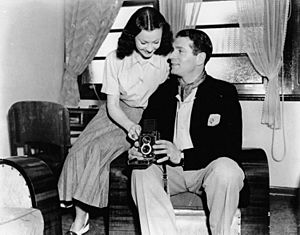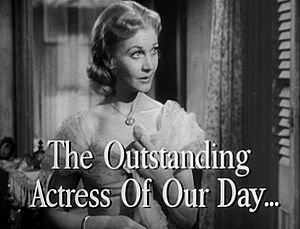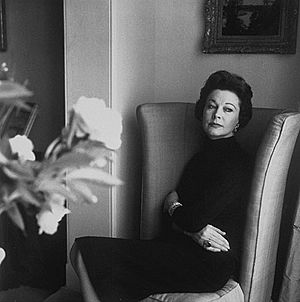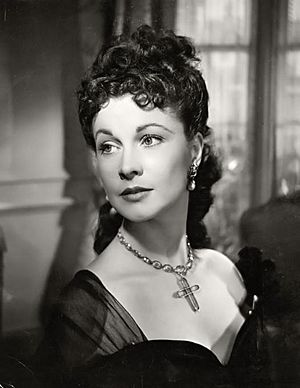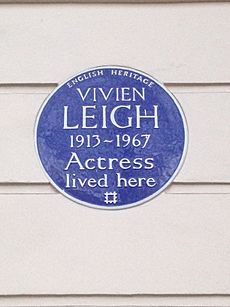Vivien Leigh facts for kids
Quick facts for kids
Vivien Leigh
|
|
|---|---|
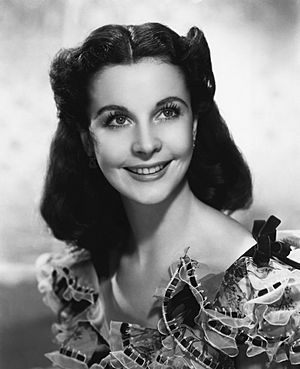
Leigh as Scarlett O'Hara in Gone with the Wind (1939)
|
|
| Born |
Vivian Mary Hartley
5 November 1913 Darjeeling, Bengal Presidency, British India
|
| Died | 8 July 1967 (aged 53) Belgravia, London, England
|
| Education |
|
| Occupation | Actress |
| Years active | 1935–1967 |
|
Notable work
|
|
| Title |
|
| Spouse(s) |
|
| Partner(s) | John Merivale (1960–1967) |
| Children | Suzanne Farrington |
| Awards | List of awards and nominations |
| Signature | |
 |
|
Vivien Leigh (born Vivian Mary Hartley; November 5, 1913 – July 8, 1967) was a famous British actress. She is known for her amazing performances in movies and plays.
Vivien won two Academy Awards for her roles. She played Scarlett O'Hara in Gone with the Wind (1939). She also starred as Blanche DuBois in the film A Streetcar Named Desire (1951). She had played this role on stage in London before.
She also won a Tony Award for her work in the Broadway musical Tovarich (1963). Even though she sometimes took breaks from acting, the American Film Institute named her the 16th greatest female movie star of classic Hollywood cinema in 1999.
Vivien Leigh started with small film roles in 1935. Soon, she became a leading actress, like in Fire Over England (1937). Many people admired her beauty. But Vivien felt her looks sometimes stopped people from seeing her as a serious actress.
She was mostly a stage actress, performing for 30 years. She played many different characters. These included funny roles in comedies and famous Shakespearean characters. Some of her Shakespeare roles were Ophelia, Cleopatra, Juliet, and Lady Macbeth. Later in her career, she also played supporting roles in a few films.
Vivien Leigh was married to the famous actor Laurence Olivier from 1940 to 1960. They often acted together on stage and in three films. Vivien faced health challenges throughout her life. She had periods of intense mood changes and also suffered from tuberculosis. This illness was first found in the mid-1940s and sadly led to her death at age 53.
Vivien Leigh's Life and Career
Early Life and First Acting Steps (1913–1934)
Vivian Mary Hartley was born on November 5, 1913. This was in British India, in a town called Darjeeling. She was the only child of Ernest Richard Hartley and Gertrude Mary Frances. Her father was a British broker. Her mother was a devout Catholic.
In 1917, her father moved for his work. Vivian and her mother stayed in Ootacamund. When she was three, Vivian first performed on stage. She recited "Little Bo-Peep" for her mother's acting group. Her mother encouraged her love for books. She introduced Vivian to stories by Hans Christian Andersen and Rudyard Kipling. She also read her tales from Greek mythology and Indian folklore.
At age six, Vivian was sent to a school in London. There, she told her friend, future actress Maureen O'Sullivan, that she wanted to be "a great actress." Later, she traveled with her parents and attended schools in Europe. She learned to speak French and Italian fluently.
In 1931, her family returned to Britain. Vivian saw Maureen O'Sullivan in a film in London. This made her want to act even more. Soon after, her father enrolled her at the Royal Academy of Dramatic Art (RADA) in London.
In 1931, Vivian met Herbert Leigh Holman, a lawyer much older than her. They married on December 20, 1932. She stopped her studies at RADA. On October 12, 1933, she gave birth to her daughter, Suzanne.
Starting Her Career (1935–1936)
Vivien's friends suggested she take a small role in the film Things Are Looking Up. This was her first movie appearance, though she wasn't credited. She hired an agent, John Gliddon. He thought "Vivian Holman" wasn't a good stage name. After many ideas, she chose "Vivian Leigh" as her professional name.
Gliddon suggested her to film producer Alexander Korda. But Korda didn't think she had much potential. However, she was cast in the play The Mask of Virtue in 1935. She received excellent reviews. Newspapers wrote about her. One article mentioned her "lightning change" in facial expressions. This was the first public note of her quick mood changes.
Korda saw her on opening night and realized his mistake. He signed her to a film contract. She continued with the play. But when it moved to a bigger theater, Vivien found it hard to project her voice. The play closed soon after. In the play's program, her first name was spelled "Vivien."
In 1960, Vivien Leigh talked about her early fame. She said some critics called her a "great actress." She felt this was a "foolish, wicked thing to say." It put a huge responsibility on her. She said it took her years to learn enough to live up to those early praises.
Meeting Laurence Olivier (1935–1939)
In 1935, Vivien Leigh met Laurence Olivier. He was a famous actor. Olivier had seen her in The Mask of Virtue and praised her acting.
Olivier and Leigh started a relationship while filming Fire Over England (1937). At this time, both were married to other people. Leigh read the book Gone with the Wind. She told her agent she wanted to play Scarlett O'Hara in the movie version. She even told a journalist, "I've cast myself as Scarlett O'Hara."
Vivien Leigh was chosen to play Ophelia in a play with Olivier. It was a production of Hamlet in Denmark. Olivier later remembered a time when her mood changed quickly before a show. She started screaming at him, then became silent. But she performed well and had no memory of the event the next day. This was the first time Olivier saw such behavior from her.
They began living together. Their spouses had refused to divorce them. Their relationship had to be kept private because of the rules in the film industry then.
Leigh appeared in A Yank at Oxford (1938). This was her first film to get attention in the United States. During filming, she gained a reputation for being difficult. This was partly because she didn't like her smaller role. Korda, the producer, warned her that her contract might not be renewed if her behavior didn't improve. Her next film was Sidewalks of London (1938) with Charles Laughton.
Olivier went to Hollywood to film Wuthering Heights (1939). Leigh stayed in London. She was offered a smaller role in the film but refused. She wanted the main female role, which went to another actress.
Gone with the Wind (1939)
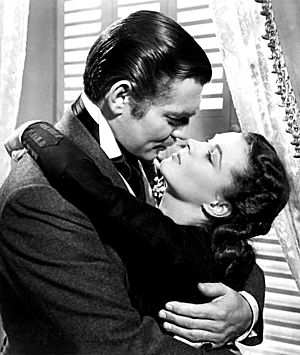
Hollywood was searching for an actress to play Scarlett O'Hara in Gone with the Wind. Vivien Leigh asked her American agent to suggest her for the part.
David O. Selznick, the film's producer, watched her in other movies. He thought she was good but "too British" for Scarlett. However, Leigh traveled to Los Angeles to be with Olivier. She also wanted to convince Selznick she was right for the role.
According to a famous story, Leigh met David Selznick on the set where a fire scene was being filmed. Her agent introduced her, saying, "Hey, genius, meet your Scarlett O'Hara." The next day, Leigh read a scene for Selznick. He set up a screen test with director George Cukor. Selznick wrote to his wife that Leigh was a "dark horse" for Scarlett. Cukor also praised Leigh's "incredible wildness." She soon got the role of Scarlett.
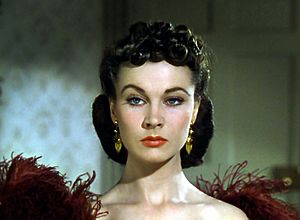
Filming Gone with the Wind was tough for Leigh. The director, Cukor, was replaced by Victor Fleming. Leigh often argued with Fleming. She and Olivia de Havilland secretly met with Cukor for advice on their roles. Leigh became friends with Clark Gable and Olivia de Havilland. But she had trouble with Leslie Howard.
Leigh sometimes worked seven days a week, often late into the night. This made her very stressed. She missed Olivier, who was working in New York City. She told him on the phone, "Puss, my puss, how I hate film acting! Hate, hate, and never want to do another film again!"
Olivia de Havilland later defended Leigh's behavior during filming. She said Vivien was "impeccably professional, impeccably disciplined." Her main worries were doing her best work and being away from Olivier.
Gone with the Wind made Leigh instantly famous. But she said, "I'm not a film star—I'm an actress." She felt being just a film star was a "false life." She believed actresses last longer and always have great parts to play. The film won 10 Academy Awards. Leigh won the Best Actress award. She also won a New York Film Critics Circle Award for Best Actress.
Marriage and Collaborations with Olivier (1940–1949)
In February 1940, Vivien and Laurence Olivier's spouses agreed to divorce them. Vivien and her first husband, Leigh Holman, remained good friends. On August 31, 1940, Olivier and Leigh married in California. Only a few close friends were there.
Leigh wanted to star with Olivier in the film Rebecca. But the producer and director thought she wasn't right for the part. She also wanted a role in Pride and Prejudice (1940), but another actress got it.
Waterloo Bridge (1940) was supposed to star Olivier and Leigh. But Olivier was replaced by Robert Taylor. The film was very popular with audiences and critics.

The Oliviers put on a stage play of Romeo and Juliet in New York. Critics were not kind. They said Leigh and Olivier "hardly act their parts at all." The play was a financial disaster for them.
The Oliviers then filmed That Hamilton Woman (1941). Olivier played Horatio Nelson and Leigh played Emma Hamilton. This film aimed to make Americans feel more supportive of Britain during the war. It was very popular in the United States and the Soviet Union. Winston Churchill loved the film and often invited the Oliviers to events. He called Leigh "a clinker," meaning she was excellent.
The Oliviers returned to Britain in 1943. Leigh toured North Africa to perform for soldiers. She reportedly turned down a huge film contract to help with the war effort. She performed for troops but then fell ill with a cough and fevers. In 1944, she was diagnosed with tuberculosis in her left lung. She spent weeks in the hospital and seemed to recover.
Leigh was filming Caesar and Cleopatra (1945) when she became pregnant. She later lost the baby. This led to a deep sadness. Olivier later learned to recognize her mood changes. He saw days of high energy followed by sadness and then a sudden outburst. After these outbursts, Leigh would not remember what happened.
In 1946, Leigh was well enough to act again. She starred in a successful play called The Skin of Our Teeth. But her films from this time, Caesar and Cleopatra (1945) and Anna Karenina (1948), were not big hits. In 1947, Olivier was knighted, becoming Sir Laurence Olivier. Vivien became Lady Olivier.
In 1948, Olivier and Leigh went on a six-month tour of Australia and New Zealand. They performed plays to raise money for the Old Vic Theatre. Leigh performed well, even though she had trouble sleeping. Olivier noted her ability to "charm the press." Some people in the company remembered arguments between the couple. Olivier later said he "lost Vivien" in Australia.
The tour was a big success. It encouraged the Oliviers to perform together in London's West End. They performed the same plays, plus Antigone, which Leigh wanted to do.
A Streetcar Named Desire (1949–1951)
Vivien Leigh then wanted to play Blanche DuBois in the London stage version of Tennessee Williams's A Streetcar Named Desire. She got the role, and Olivier directed it.
When the play opened in October 1949, some critics didn't like it. But others, like Noël Coward, called Leigh "magnificent."
After 326 performances, Leigh finished her run. She was then chosen to play Blanche DuBois again in the film version. She got along well with Marlon Brando, her co-star. But she found it hard to work with the director, Elia Kazan. He thought Olivier's direction of Blanche was wrong. Kazan later said Leigh had "the greatest determination to excel." She would have done anything to improve her performance. Leigh found the role very demanding. She told the Los Angeles Times, "I had nine months in the theatre of Blanche DuBois. Now she's in command of me."
Leigh's performance in A Streetcar Named Desire received glowing reviews. She won a second Academy Award for Best Actress. She also won a British Academy of Film and Television Arts (BAFTA) Award and a New York Film Critics Circle Award. Tennessee Williams said Leigh brought everything he intended to the role, "and much that I had never dreamed of." Leigh herself had mixed feelings about the character. She later said playing Blanche DuBois "tipped me over into madness."
Health Challenges (1951–1960)
In 1951, Leigh and Laurence Olivier performed two plays about Cleopatra. They were William Shakespeare's Antony and Cleopatra and George Bernard Shaw's Caesar and Cleopatra. They performed them on alternating nights and got good reviews. They took the plays to New York in 1952. Most reviews there were positive. But one critic, Kenneth Tynan, said Leigh's talent was only average. This upset her greatly. Leigh was afraid of failing and wanted to be great. She focused on his negative comments and ignored the good reviews.
In January 1953, Leigh went to Sri Lanka to film Elephant Walk. Soon after filming started, she had a health crisis. Paramount Pictures replaced her with Elizabeth Taylor. Olivier brought her home to Britain. During this time, Leigh told him she was in love with Peter Finch. She slowly recovered over several months. Many of their friends learned about her health problems.
In 1953, Leigh recovered enough to act in The Sleeping Prince with Olivier. In 1955, they performed Shakespeare's Twelfth Night, Macbeth, and Titus Andronicus. They played to full houses and got good reviews. Leigh's health seemed stable.
In 1956, Leigh took the lead role in the play South Sea Bubble. But she had to leave the production when she became pregnant. A few weeks later, she lost the baby. This led to a period of sadness that lasted for months. She joined Olivier for a European tour of Titus Andronicus. But the tour was difficult because of Leigh's frequent outbursts. After they returned to London, her first husband, Leigh Holman, helped calm her.
In 1959, she had a success with the comedy Look After Lulu!. A critic from The Times newspaper called her "beautiful, delectably cool and matter of fact."
In 1960, Leigh started a relationship with actor Jack Merivale. He knew about her health condition and promised Olivier he would take care of her.
In 1960, she and Olivier divorced. Olivier soon married actress Joan Plowright. In his book, Olivier wrote about the stress they faced because of Leigh's health. He said she was able to hide her true condition from almost everyone except him.
Final Years and Death (1961–1967)
Merivale was a good influence on Leigh. She seemed happy, but she once told a friend she "would rather have lived a short life with Larry [Olivier] than face a long one without him." Her first husband, Leigh Holman, also spent a lot of time with her.
Merivale joined her for a tour of Australia, New Zealand, and Latin America from 1961 to 1962. Leigh received good reviews without sharing the spotlight with Olivier. Even though she still had periods of sadness, she kept working in the theater. In 1963, she won a Tony Award for her role in Tovarich. She also appeared in the films The Roman Spring of Mrs. Stone (1961) and Ship of Fools (1965).
Leigh's last film was Ship of Fools. It was a success but also showed her health struggles. The director, Stanley Kramer, remembered her courage in taking on the difficult role. He said her bravery to make the film was "almost unbelievable." Leigh's performance was affected by her health, leading to outbursts. But her co-stars, Simone Signoret and Lee Marvin, were understanding. Leigh won an award for her performance in Ship of Fools.
In May 1967, Leigh was rehearsing for a play when her tuberculosis returned. After resting, she seemed to get better. On the night of July 7, 1967, Merivale left her at their home to perform in a play. He returned home just before midnight and found her asleep. About 30 minutes later, he found her body on the floor. She had tried to walk to the bathroom but collapsed. Her lungs filled with liquid, and she suffocated. Merivale contacted her family and then Olivier. Olivier was in a hospital nearby. He immediately went to Leigh's home. He paid his respects and helped Merivale with funeral plans.
Her death was announced publicly on July 8. The lights of every theater in central London were turned off for an hour. A Catholic service was held for Leigh. Her funeral was attended by many famous British actors. Leigh was cremated, and her ashes were scattered on the lake at her summer home in England. A memorial service was held, and John Gielgud gave a final tribute. In 1968, Leigh was the first actress honored by "The Friends of the Libraries at the University of Southern California" in the United States.
Vivien Leigh's Legacy
Vivien Leigh was thought to be one of the most beautiful actresses of her time. Her directors often highlighted her beauty in her films. When asked if her beauty made it hard for her to be taken seriously as an actress, she said, "People think that if you look fairly reasonable, you can't possibly act." She felt beauty could be a "great handicap" if you truly wanted to look like the character you were playing.
Director George Cukor called Leigh a "consummate actress, hampered by beauty." Laurence Olivier said critics should "give her credit for being an actress and not go on forever letting their judgments be distorted by her great beauty." Garson Kanin agreed, saying Leigh was a "stunner whose ravishing beauty often tended to obscure her staggering achievements as an actress." He added that she was "ambitious, persevering, serious, often inspired."
Leigh explained that she played "as many different parts as possible." She did this to improve her acting and to change ideas about her skills. She believed that comedy was harder to perform than drama. This is because comedy needs very precise timing. She felt that comedy should be taught more in acting schools. Near the end of her career, she said, "It's much easier to make people cry than to make them laugh."
Her early performances brought her quick success in Britain. But she was not well known elsewhere until Gone with the Wind was released. In December 1939, film critic Frank Nugent wrote that Leigh's Scarlett was "perfectly designed for the part." He said any other actress in the role would be "inconceivable." As her fame grew, she appeared on the cover of Time magazine as Scarlett. In 1969, critic Andrew Sarris said the film's success was largely due to Leigh's "inspired casting." Film historian Leonard Maltin called the film one of the greatest ever. He wrote in 1998 that Leigh "brilliantly played" her role.
Her performance in the London play A Streetcar Named Desire showed her great acting powers. This led to a long period where she was seen as one of the best actresses in British theater. About the film version, Pauline Kael wrote that Leigh and Marlon Brando gave "two of the greatest performances ever put on film." She said Leigh's performance was "one of those rare performances that can truly be said to evoke both fear and pity."
One of her biggest critics was Kenneth Tynan. He made fun of Leigh's performance in the 1955 play Titus Andronicus. He also criticized her role as Lady Macbeth in 1955. He said her performance was weak and lacked the needed anger. However, after her death, Tynan changed his mind. He called his earlier criticism "one of the worst errors of judgment" he had ever made. After Leigh's death, many theater critics said her performance as Lady Macbeth was one of her greatest achievements.
In 1969, a plaque for Leigh was placed in the Actors' Church in London. In 1985, her portrait was on a series of United Kingdom postage stamps. This was to celebrate "British Film Year." She appeared on another stamp in 1996 with Sir Laurence Olivier. In 2013, she was again included in a series celebrating her 100th birthday.
The British Library in London bought Olivier's papers in 1999. This collection includes many of Leigh's personal papers and letters to Olivier. Leigh's own papers, including letters, photos, and diaries, are owned by her daughter. In 1994, the National Library of Australia bought a photo album believed to belong to the Oliviers. It has 573 photos of the couple during their 1948 tour of Australia. In 2013, a large collection of Leigh's items was bought by the Victoria and Albert Museum in London. This included letters, diaries, photos, and awards. Also in 2013, Leigh was one of ten people chosen by the Royal Mail for their "Great Britons" postage stamp issue.
Filmography
Accolades
| Organizations | Year | Category | Work | Result |
|---|---|---|---|---|
| Academy Awards | 1940 | Best Actress | Gone with the Wind | Won |
| 1952 | A Streetcar Named Desire | Won | ||
| BAFTA Awards | 1953 | Best Film British Actress | Won | |
| Faro Island Film Festival | 1939 | Audience Award for Best Actress | Gone with the Wind | Nominated |
| Golden Globe Awards | 1952 | Best Actress in a Motion Picture – Drama | A Streetcar Named Desire | Nominated |
| National Board of Review of Motion Pictures Awards | 1940 | Best Acting | Gone with the Wind & Waterloo Bridge | Won |
| New York Film Critics Circle Awards | 1939 | Best Actress | Gone with the Wind | Won |
| 1951 | A Streetcar Named Desire | Won | ||
| Online Film & Television Association Awards | 2001 | Film Hall of Fame Induction | N/A | Honored |
| Sant Jordi Awards | 1957 | Special Award for Acting | A Streetcar Named Desire | Honored |
| Venice Film Festival | 1951 | Volpi Cup for Best Actress | Won | |
| Hollywood Walk of Fame | 1960 | Hollywood Walk of Fame Star | N/A | Honored |
See also
 In Spanish: Vivien Leigh para niños
In Spanish: Vivien Leigh para niños


